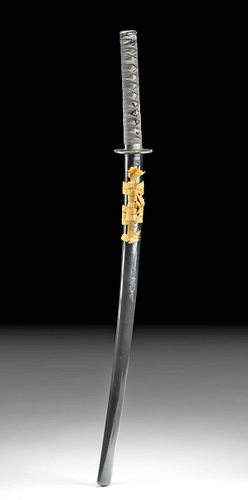Japanese Muromachi Steel & Lacquered Wood Wakizashi
Lot 65
About Seller
Artemis Gallery
686 S Taylor Ave, Ste 106
Louisville, CO 80027
United States
Selling antiquities, ancient and ethnographic art online since 1993, Artemis Gallery specializes in Classical Antiquities (Egyptian, Greek, Roman, Near Eastern), Asian, Pre-Columbian, African / Tribal / Oceanographic art. Our extensive inventory includes pottery, stone, metal, wood, glass and textil...Read more
Categories
Estimate:
$3,000 - $4,500
Absentee vs Live bid
Two ways to bid:
- Leave a max absentee bid and the platform will bid on your behalf up to your maximum bid during the live auction.
- Bid live during the auction and your bids will be submitted real-time to the auctioneer.
Bid Increments
| Price | Bid Increment |
|---|---|
| $0 | $25 |
| $300 | $50 |
| $1,000 | $100 |
| $2,000 | $250 |
| $5,000 | $500 |
| $10,000 | $1,000 |
| $20,000 | $2,500 |
| $50,000 | $5,000 |
| $100,000 | $10,000 |
| $200,000 | $20,000 |
About Auction
By Artemis Gallery
Dec 2, 2021
Set Reminder
2021-12-02 10:00:00
2021-12-02 10:00:00
America/New_York
Bidsquare
Bidsquare : Fine Antiquities | Asian | Ethnographic Art
https://www.bidsquare.com/auctions/artemis-gallery/fine-antiquities-asian-ethnographic-art-7918
Features classical antiquities, ancient and ethnographic art from cultures encompassing the globe. Egyptian, Greek, Roman, Etruscan, Near Eastern, Asian, Pre-Columbian, Native American, African / Tribal, Oceanic, Spanish Colonial, Russian, Fine / Visual Arts, so much more! Artemis Gallery info@artemisgallery.com
Features classical antiquities, ancient and ethnographic art from cultures encompassing the globe. Egyptian, Greek, Roman, Etruscan, Near Eastern, Asian, Pre-Columbian, Native American, African / Tribal, Oceanic, Spanish Colonial, Russian, Fine / Visual Arts, so much more! Artemis Gallery info@artemisgallery.com
- Lot Description
East Asia, Japan, late Muromachi period, ca. third quarter of the 16th century CE. A beautiful wakizashi with a single-edged blade, a lacquered (urushi) wood scabbard (saya), and a handle (tsuka) wrapped with reptile skin and cotton straps (tsuka-ito) topped with a brass cap (kashira). A pair of handle ornaments (menuki) depict two mice on one side and a bird resting near a leaf on the other. The minimalist hand guard (marugata tsuba) rests between a pair of copper blade caps (fuchi). The shinogi-zukuri steel blade has a higher ridge line than the typical shobu-zukuri design, a diamond-shaped (iori-mune) profile, and a gently curved tip (chu-kissaki), all forged by the tight-grained hammer-folding process (itame-hada) with an irregular wavy temper pattern (gunome-choji). The blade tang has been intentionally shortened (o-suriage) to better accommodate the handle. Size (w/ sheath): 2.56" W x 32.1" H (6.5 cm x 81.5 cm); (blade): 19.9" L (50.5 cm)
This traditional Japanese sword was both a weapon and a symbol of authority and social status. The wakizashi paired with the longer katana sword marked the wearer as a samurai. The shorter sword was seen as an auxiliary weapon, also used for fighting in close quarters. Wakizashi could also be worn by non-samurai if worn alone, and members of the merchant class (chonin) wore them because of the frequency of encountering bandits when traveling between Japan's cities.
Over the centuries that katana and wakizashi were made, the process of their manufacture became heavily regulated. For example, in 1683, the Tokugawa Shogunate made laws concerning the maximum size of katana and wakizashi. Meanwhile, once a samurai took ownership of his new weapon, he had to wear it in a highly regulated manner. Wakizashi and katana in this period were both deadly weapons and signs of prestige. The craftsmanship of this piece is evident and reflects hundreds of hours of work.
Provenance: private Jones collection, Boulder, Colorado, USA; ex-private Sacramento, California, USA collection
All items legal to buy/sell under U.S. Statute covering cultural patrimony Code 2600, CHAPTER 14, and are guaranteed to be as described or your money back.
A Certificate of Authenticity will accompany all winning bids.
PLEASE NOTE: Due to recent increases of shipments being seized by Australian & German customs (even for items with pre-UNESCO provenance), we will no longer ship most antiquities and ancient Chinese art to Australia & Germany. For categories of items that are acceptable to ship to Australia or Germany, please contact us directly or work with your local customs brokerage firm.
Display stands not described as included/custom in the item description are for photography purposes only and will not be included with the item upon shipping.
#168333Scabbard is perhaps a later addition or replacement of the original; yellow cotton strap on scabbard is modern. Minor abrasions to blade, blade caps, and hand guard, with smoothing to scales on reptile skin handle panels commensurate with age and use, and nicks to areas of blade faces. Wonderful patina throughout. Blade edge is still incredibly sharp, so please handle with caution.Condition
- Shipping Info
-
All shipping is handled in-house for your convenience. Your invoice from Artemis Gallery will include shipping calculation instructions. If in doubt, please inquire BEFORE bidding for estimated shipping costs for individual items.
-
- Buyer's Premium



 EUR
EUR CAD
CAD AUD
AUD GBP
GBP MXN
MXN HKD
HKD CNY
CNY MYR
MYR SEK
SEK SGD
SGD CHF
CHF THB
THB













